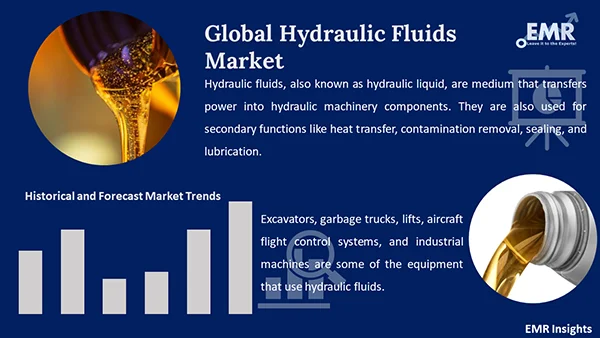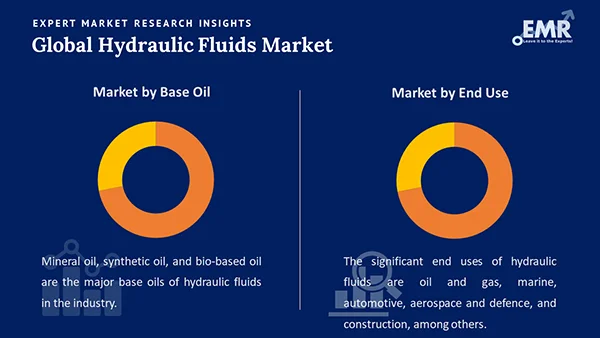
Consumer Insights
Uncover trends and behaviors shaping consumer choices today
Procurement Insights
Optimize your sourcing strategy with key market data
Industry Stats
Stay ahead with the latest trends and market analysis.
The global hydraulic fluids market attained a value of more than USD 9.17 Billion in 2025. The market is further expected to grow in the forecast period of 2026-2035 at a CAGR of 6.60% to reach above USD 17.38 Billion by 2035.
Base Year
Historical Period
Forecast Period
Compound Annual Growth Rate
6.6%
Value in USD Billion
2026-2035
*this image is indicative*
The Asia Pacific accounts for a considerable share of the hydraulic fluid industry due to rapid industrialisation in developing economies like India and China. The increasing construction activities owing to the rising requirement to accommodate the growing population in the region is driving the market for hydraulic fluids. With the growing utilisation of hydraulic machines for the precision and optimisation of construction processes, the demand for hydraulic fuels is increasing, hence driving the market growth.

Read more about this report - REQUEST FREE SAMPLE COPY IN PDF
Moreover, the increasing manufacturing of automobiles in countries like China and India, among others, is leading to a surge in the demand for hydraulic fluids, which is significantly contributing to the growth of the market. As hydraulic fluids can effectively handle high pressures, they are increasingly preferred in heavy duty applications in the region, which is providing further impetus to the growth of the hydraulic fluids industry.

Read more about this report - REQUEST FREE SAMPLE COPY IN PDF
Hydraulic fluids, also known as hydraulic liquid, are medium that transfers power into hydraulic machinery components. They are also used for secondary functions like heat transfer, contamination removal, sealing, and lubrication. Excavators, garbage trucks, lifts, aircraft flight control systems, and industrial machines are some of the equipment that use hydraulic fluids. They find their applications in major industries like oil and gas, automotive, and aerospace, among others.
The major base oils of hydraulic fluids are:
The market can be broadly categorised on the basis of its end uses into:
The EMR report looks into the regional markets of hydraulic fluids like:
The growing use of hydraulic equipment in various industries, such as construction and automotive, among others, are driving the growth of the hydraulic fluids industry. As hydraulic systems are designed to operate under high temperatures, high pressures, and various complex circumstances, they are extensively deployed in challenging applications, hence bolstering the market growth. The increasing use of hydraulic fluid to decrease the wear and tear of parts, protect the internal systems from corrosion, and external environments from erosion, is augmenting the growth of the market.
With the growing sustainability concerns, the use of hydraulic fluids for the functional safety of systems is fuelling the market growth. The development of innovative seals that are compatible with hydraulic fluids is projected to propel the market growth. Furthermore, advancements in fluid technology of hydraulic systems are expected to enhance the applications of hydraulic fluid, which is anticipated to fuel the market growth.
The report presents a detailed analysis of the following key players in the global hydraulic fluids market, looking into their capacity, market shares, and latest developments like capacity expansions, plant turnarounds, and mergers and acquisitions:
The comprehensive report looks into the macro and micro aspects of the industry. The EMR report gives an in-depth insight into the market by providing a SWOT analysis as well as an analysis of Porter’s Five Forces model.




*While we strive to always give you current and accurate information, the numbers depicted on the website are indicative and may differ from the actual numbers in the main report. At Expert Market Research, we aim to bring you the latest insights and trends in the market. Using our analyses and forecasts, stakeholders can understand the market dynamics, navigate challenges, and capitalize on opportunities to make data-driven strategic decisions.*
Get in touch with us for a customized solution tailored to your unique requirements and save upto 35%!
In 2025, the global hydraulic fluids market attained a value of more than USD 9.17 Billion.
The market is projected to grow at a CAGR of 6.60% between 2026 and 2035.
The market is estimated to witness a healthy growth in the forecast period of 2026-2035 to reach above USD 17.38 Billion by 2035.
The market is being driven by the rising construction activities, rapid industrialisation, and the robust growth of the automotive industry.
The market growth in the forecast period can be attributed to the rising use of hydraulic equipment, the growing sustainability concerns, and advancements in fluid technology.
The major regions in the industry are North America, Latin America, the Middle East and Africa, Europe, and the Asia Pacific.
Mineral oil, synthetic oil, and bio-based oil are the major base oils of hydraulic fluids in the industry.
The significant end uses of hydraulic fluids are oil and gas, marine, automotive, aerospace and defence, and construction, among others.
The major players in the industry are Royal Dutch Shell plc., Exxon Mobil Corporation, BASF SE, Chevron Corporation, and TotalEnergies SE, among others.
Explore our key highlights of the report and gain a concise overview of key findings, trends, and actionable insights that will empower your strategic decisions.
| REPORT FEATURES | DETAILS |
| Base Year | 2025 |
| Historical Period | 2019-2025 |
| Forecast Period | 2026-2035 |
| Scope of the Report |
Historical and Forecast Trends, Industry Drivers and Constraints, Historical and Forecast Market Analysis by Segment:
|
| Breakup by Base Oil |
|
| Breakup by End Use |
|
| Breakup by Region |
|
| Market Dynamics |
|
| Competitive Landscape |
|
| Companies Covered |
|
| Report Price and Purchase Option | Explore our purchase options that are best suited to your resources and industry needs. |
| Delivery Format | Delivered as an attached PDF and Excel through email, with an option of receiving an editable PPT, according to the purchase option. |
Datasheet
One User
USD 2,499
USD 2,249
tax inclusive*
Single User License
One User
USD 3,999
USD 3,599
tax inclusive*
Five User License
Five User
USD 4,999
USD 4,249
tax inclusive*
Corporate License
Unlimited Users
USD 5,999
USD 5,099
tax inclusive*
*Please note that the prices mentioned below are starting prices for each bundle type. Kindly contact our team for further details.*
Flash Bundle
Small Business Bundle
Growth Bundle
Enterprise Bundle
*Please note that the prices mentioned below are starting prices for each bundle type. Kindly contact our team for further details.*
Flash Bundle
Number of Reports: 3
20%
tax inclusive*
Small Business Bundle
Number of Reports: 5
25%
tax inclusive*
Growth Bundle
Number of Reports: 8
30%
tax inclusive*
Enterprise Bundle
Number of Reports: 10
35%
tax inclusive*
How To Order

Select License Type
Choose the right license for your needs and access rights.

Click on ‘Buy Now’
Add the report to your cart with one click and proceed to register.

Select Mode of Payment
Choose a payment option for a secure checkout. You will be redirected accordingly.
Gain insights to stay ahead and seize opportunities.

Get insights & trends for a competitive edge.

Track prices with detailed trend reports.

Analyse trade data for supply chain insights.

Leverage cost reports for smart savings

Enhance supply chain with partnerships.

Connect For More Information
Our expert team of analysts will offer full support and resolve any queries regarding the report, before and after the purchase.
Our expert team of analysts will offer full support and resolve any queries regarding the report, before and after the purchase.
We employ meticulous research methods, blending advanced analytics and expert insights to deliver accurate, actionable industry intelligence, staying ahead of competitors.
Our skilled analysts offer unparalleled competitive advantage with detailed insights on current and emerging markets, ensuring your strategic edge.
We offer an in-depth yet simplified presentation of industry insights and analysis to meet your specific requirements effectively.
Share